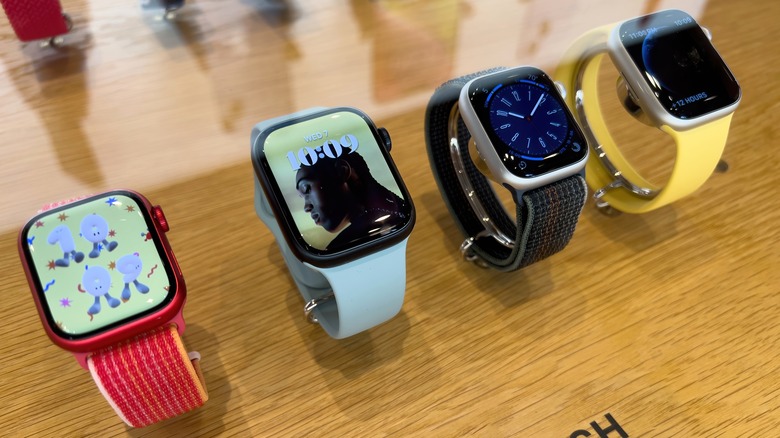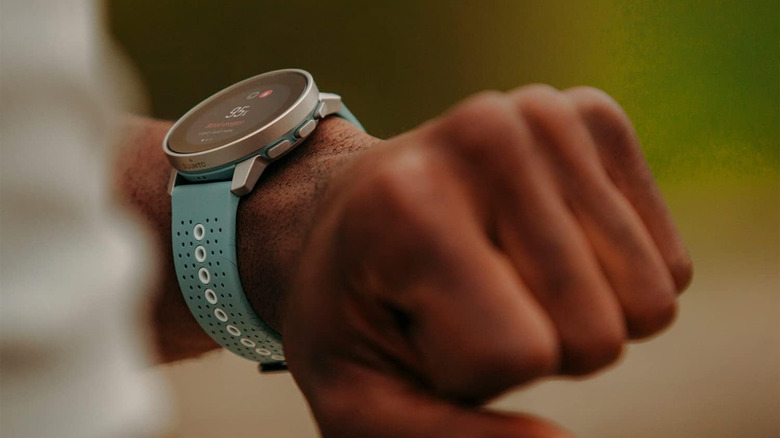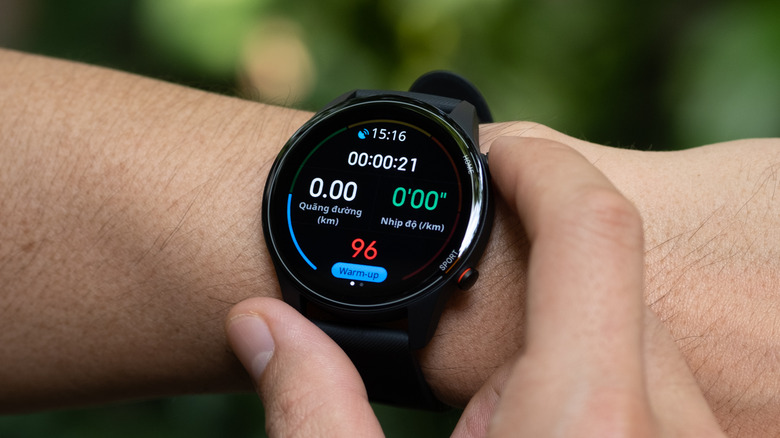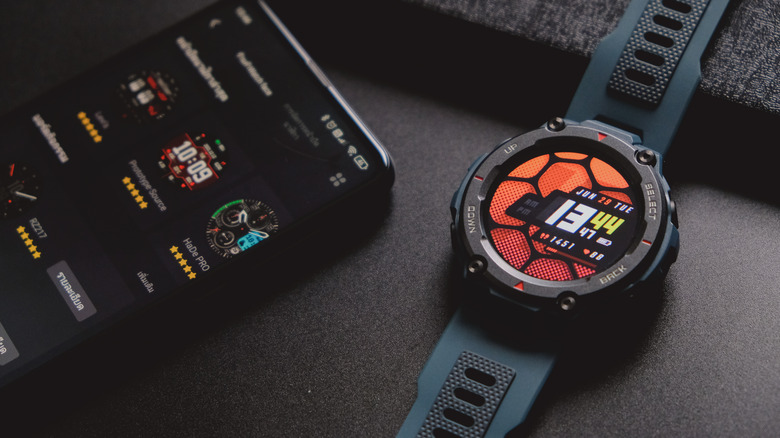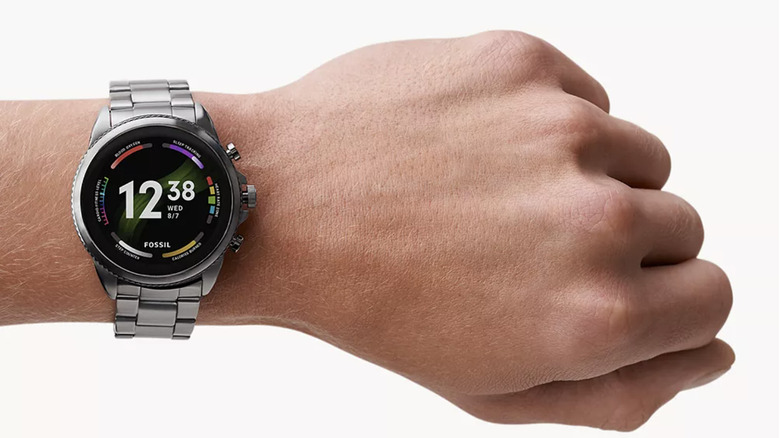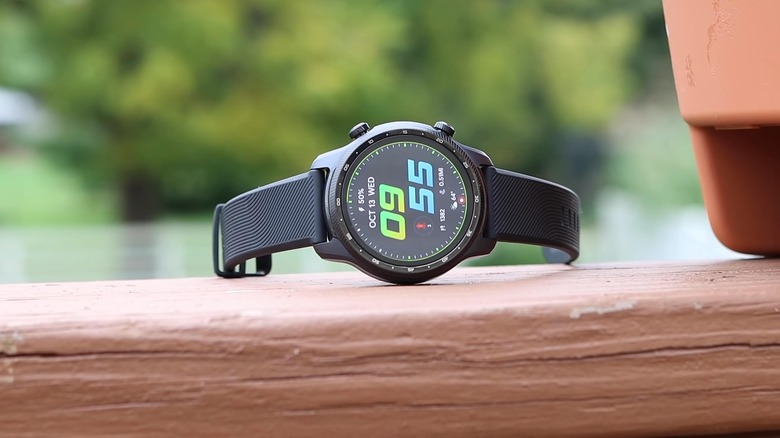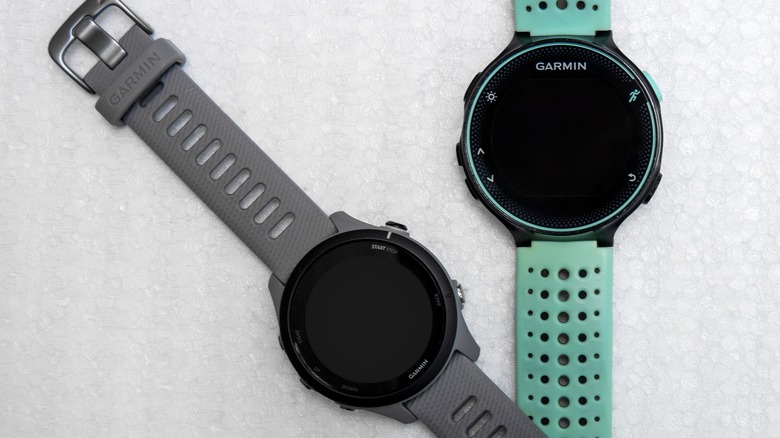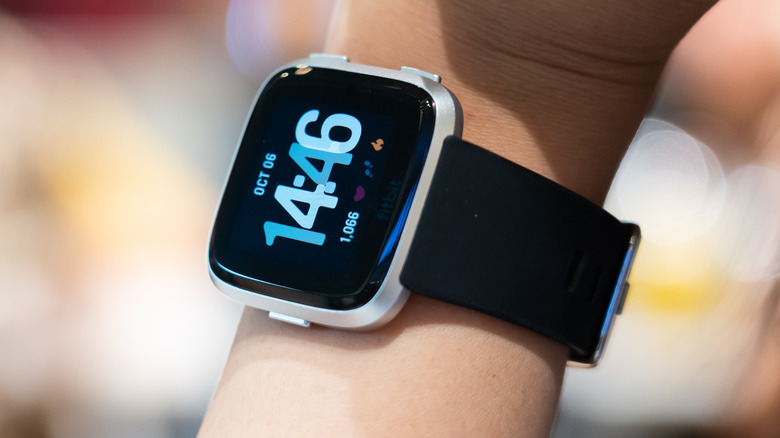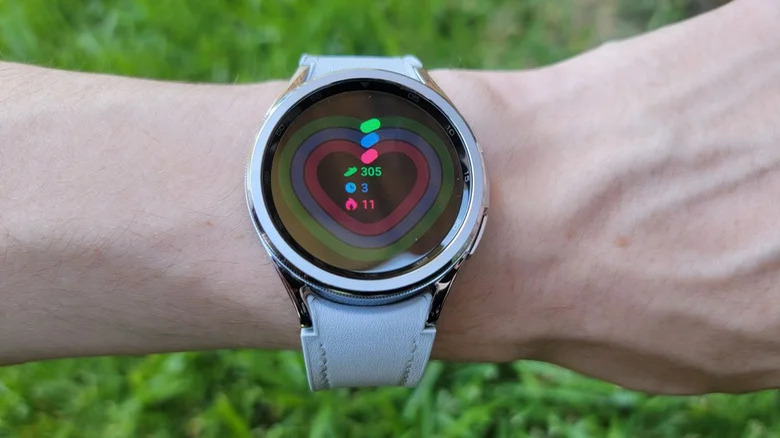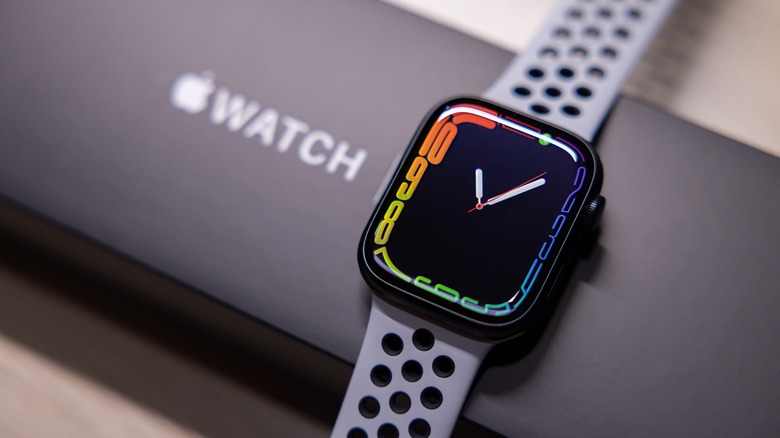Every Major Smartwatch Brand Ranked From Worst To Best
Smartwatches aren't new by any stretch, but the technology seems to finally be taking off after years of false starts. In fact, smartwatches have grown in popularity every year since 2017. This is due to a variety of factors, including increased availability and improvements in hardware. It also doesn't hurt that the Apple Watch is insanely popular. The benefit of smartwatches is that they're an extension of your phone and that lets you manage a variety of things from your wrist without the need to pull your phone out for everything.
By and large, smartwatches are homing in on the same market that is currently dominated by fitness trackers. There isn't a huge difference between fitness trackers and smartwatches. Generally speaking, fitness trackers are designed specifically to track your fitness. Smartwatches do fitness tracking as well, but can also run apps and deal with notifications. Some can even accept SIM cards and make phone calls. The added functionality gives smartwatches a leg up on fitness trackers. Fitness trackers, however, tend to have much better battery life.
The only real downside to smartwatches is that you're essentially locked into your current smartphone ecosystem. For example, Apple Watches only work with iPhones. Meanwhile, Samsung's excellent Galaxy Watch 6 works on all Android phones but has some features exclusive to Samsung phones. That can stifle choice on the part of consumers. Still, there are some smartwatch OEMs that are worth paying attention to.
Here are the major smartphone brands ranked from worst to best.
9. Suunto
Suunto is an up-and-coming smartwatch OEM. The company makes several lineups of smartwatches, including the Suunto 9 Peak, 9 Baro, 5 Peak, and the 7. Of those, only the Suunto 7 uses Wear OS, and the rest are much simpler fitness tracker-level watches that work with a smartphone companion app. The Suunto 7 is fairly expensive with a $399.99 MSRP but has been praised for its functionality and design.
What makes Suunto promising as a smartwatch brand is that it knocked its first attempt out of the park. The Suunto 7 has an excellent screen, good GPS tracking, reasonably modern fitness features, and a chic design to go with satisfactory Wear OS 3 integration. The device tends to suffer from average battery life. There is also only one size. Thus, other smartwatch brands may be better options if you need something super specific. Plus, with Wear OS 4 out now, Wear OS 3 is starting to feel a little outdated.
The unfortunate thing is that Suunto released its last Wear OS watch back in 2020 — a practically paleolithic age considering how fast technology moves these days. It's not even known for sure if Suunto is going to release another Wear OS smartwatch. Until then, you do have the 9 Peak and 9 Baro to choose from, and Suunto seems content to battle it out with Fitbit and Garmin in the fitness tracker space for now.
8. Xiaomi
Xiaomi is an interesting smartwatch brand. It only has five smartwatch models: The Xiaomi Mi Watch, Redmi Watch 3, Redmi 3 Active, S1, and S1 Active. Nestled in that lineup are some extra variants. Xiaomi also sells the Smart Band, which is a series of fitness trackers to round out its lineup. Here's the thing: The Mi Watch is pretty decent. It's inexpensive, has plenty of fitness-oriented features, and comes with Amazon Alexa support. Pair that with battery life that measures in weeks rather than days, and you have a pretty competent overall smartwatch. The Mi Watch is available on Amazon and other retailers for under $150. That's much cheaper than the higher-end competition.
The other Xiaomi smartwatches worth talking about are the S1 and S1 Active. They are also budget-friendly smartwatches with long battery life, decent features, and a sub-$150 price tag. This is the theme that makes Xiaomi products interesting. They last for a long time, do the smartwatch basics, and don't cost an arm and a leg. However, there are some caveats. Multiple sources have stated that fitness tracking is hit-or-miss, but it's good enough for basic stuff.
The Redmi Watch 3 and 3 Active are the other two Xiaomi smartwatches, but they're not available worldwide yet. Xiaomi's lack of global availability is what relegates it to the bottom tier of smartwatch brands. The company's products are good for what they are, and they are also among the cheapest smartwatches on the market. However, they are a bit weaker in terms of features than competitors' offerings and all of Xiaomi's products have questionable availability. There is a rumor that Xiaomi is releasing a Wear OS smartwatch sometime in 2023. If true, Xiaomi could jump up a few spaces on this list.
7. AmazFit
Amazfit is a Chinese brand that is on the rise. The brand has shipped over 100 million units since 2014, so it's new to Westerners, but not the world. As such, the brand has a variety of products, including its GTR, GTS, T-Rex, Cheetah, and Bip lineups. It competes directly with brands like Garmin and Fitbit. For example, the T-Rex brand is built for durability similar to the Garmin Instinct. The GTR, by contrast, competes with the likes of the Fitbit Versa and Sense. Even the non-smartwatch Amazfit Band 7 is a surprisingly great fitness tracker. These things are all over Amazon, and you've likely seen them before if you've searched the site for smartwatches recently.
The pros and cons of Amazfit smartwatches are essentially the same as other non-Wear OS smartwatches. You get excellent battery life, quick performance, decent fitness tracking, and support for Android and iOS. However, the device lacks the refinement of a more mature smartwatch OS. That means your notifications may be occasionally buggy, there isn't a good contactless payment solution, and there is a lot of plastic. However, in return to those compromises, consumers can get a smartwatch at a very reasonable price. Very nearly every Amazfit smartwatch costs under $200.
Amazfit is in a good position for the future. The company has a large product library which it updates consistently. However, without better actual smartwatch features, it'll pale in comparison to its more expensive counterparts. There are some good products here, especially if you want to keep it simple, but there are better options if you have a little extra money to spend.
6. Fossil
Fossil is Samsung's biggest competitor in the Wear OS smartwatch space, at least when it comes to sharing space on retail shelves. Fossil smartwatches are widely available, reasonably priced, and have a good number of features. The most recent model, the Gen 6, comes in a few different colors as well as in 42- and 44-millimeter sizes. The Gen 6 design is fairly conservative, but it looks nice without being too polarizing.
In terms of usability, Fossil could do better. Battery life is just average at best and it only just received Wear OS 3 in June 2023. That means many early adopters were stuck on Wear OS 2 at the watch's launch. It's also problematic since the Galaxy Watch 4 launched with Wear OS 4 just two months later. Aside from that, Fossil watches come with reasonably modern specs, good performance, and decent fitness tracking via Google Fit. All in all, Fossil watches are decent for the price range, but they could be better.
Fossil also owns Skagen and Michael Kors. Both of those brands produce Wear OS smartwatches as well. In fact, the Michael Kors Gen 6 has the same internal hardware, features, and Wear OS version as its Fossil sibling, as does the Skagen Falster Gen 6. As a result, even buying within Fossil's sub-brands nets you about the same experience overall. Fossil is good enough for most smartwatch functions, without being the best at any one thing.
5. Mobvoi TikWatch
Mobvoi has a few above-average smartwatches in its lineup. The company started gaining real popularity with the TicWatch Pro 3 Ultra and seems to be doing quite well with the TicWatch 5 Pro. The TicWatch E3, a budget-oriented smartwatch, rounds out Mobvoi's offerings. Unlike most competitors, each TicWatch only comes in a single size and is also not widely available at physical retailers. While the smartwatch is available online, Mobvoi finds itself at an obvious disadvantage to Samsung and Apple, though the company makes up for it in other ways.
Perhaps the watch's coolest trick is the second screen on the TicWatch 3 Pro and 5 Pro. This ultra-low power screen turns on when the main AMOLED panel turns off and gives users an always-on display for a fraction of the battery drain of the main screen. The ULP screen looks a little bit like a standard, old-school digital watch, but you can quickly get back to the AMOLED display when needed. On top of its Wear OS features, the TicWatch 5 Pro includes a heart rate monitor, SpO2 sensor, and more. Many of those fitness features are also viewable on the ULP display to help save battery.
Mobvoi's pros and cons are fairly evident. The three smartwatches the company has out right now are among the best in the Wear OS ecosystem with modern features and specs. However, the lack of sizing and mass availability makes them a bit more difficult to approach from a consumer standpoint compared to competitors like Fossil and Samsung.
4. Garmin
Garmin is a pretty big player in the smartwatch space. The company has six different products on the market. They are the Venu, Forerunner, Instinct, Epix, Fenix, and Vivoactive. All six use GarminOS for the operating system, which is similar in terms of functionality to FitbitOS. Each smartwatch is designed for varying levels of fitness tracking and activities. For example, the Instinct is built primarily for rugged activities like hiking or mountain biking. The Venu, by contrast, is designed to do the basics and look nice. There's a Garmin smartwatch for any occasion and they come in a variety of sizes.
In general, you get the usual set of fitness tracking features with any Garmin watch. That includes heart rating monitoring, a pedometer function, GPS, and more. Modern Garmin watches like the Forerunner 265 and the Forerunner 955 come with extras like Training Readiness, a metric that combines sleep scores, recovery time, training load, and others to give you a single score of how ready you are to train. Smartwatch-oriented features include music controls, notifications, support for phone calls, and some customization features.
Wear OS is more powerful as far as smartwatch operating systems are concerned, but GarminOS is excellent for fitness. Plus, it's usable on iOS and Android equally. Garmin makes some of the most durable and rugged smartwatches on the market today. Much like other competitors, Garmin releases new smartwatches every year. Those looking for something a little less connected, but still in the realm of a smartwatch should check out Garmin's products.
3. Fitbit and Google
Fitbit has been in the smartwatch space for a long time. Google, by comparison, only just released its first Pixel Watch in 2022. Fitbit competes in this space mostly with fitness trackers, but the company's Versa and Sense devices fall under the smartwatch definition. Since Google owns Fitbit, the two are essentially one OEM at this point, and it wouldn't be shocking to see Fitbit devices shipping with Wear OS eventually. For the time being, Fitbit leads the way with its experience and offerings.
The Google Pixel Watch is a reasonably good smartwatch. The specs are a little behind the times, but it makes up the difference with a clean overall experience, and a good screen while integrating Fitbit's familiar fitness tracking features like no other smartwatch. A Fitbit subscription is required to use these features, which isn't ideal, but some features are available for free. On the other end of the product lineup, the Versa and Sense devices come with Fitbit's OS and fitness tracking baked in but don't have the app selection and customization support of a Wear OS product.
Fitbit releases new products yearly. Google's release schedule for the Pixel Watch isn't clear yet since there is only one. However, it's reasonable to expect the next Pixel Watch to be much more competitive with Fossil and Samsung smartwatches. Fitbit's devices have been competitive for years and should remain so for the foreseeable future. It also helps that Fitbit's products are compatible with both iOS and Android, whereas the Pixel Watch is only usable on Android.
2. Samsung
Samsung has a real winner with its Galaxy Watch series of smartwatches. The most recent iteration, the Galaxy Watch 6, is some of Samsung's best work yet and it even launches with the latest Wear OS 4, making it the preeminent Wear OS device on the market. The Galaxy Watch Classic comes in 43- and 47-millimeter sizes while the regular variant comes in 40 and 44 millimeters. Retailers also generally have older variants on the shelves long after the newest version comes out. That gives shoppers plenty of options, and it gives Samsung plenty of visibility in retail stores.
The Galaxy Watch has leaped out in front of the pack when it comes to features. Samsung re-introduced the rotating bezel on the Galaxy Watch 6 Classic, which was a fan favorite on earlier models. Some of the fitness features include heart rate sensors with ECG support, sleep tracking, emergency SOS, fall detection, and health tracking via Samsung Health. Unfortunately, some of those, like the ECG support, are only available on Samsung phones, so the experience isn't ubiquitous across all Android devices.
Like the Apple Watch, Samsung's modern Galaxy Watch lineup is only available on its native platform. That means only Android phone owners can connect their phones to the Galaxy Watch. However, Samsung's older watches used Tizen instead of Wear OS. Tizen smartwatches can be used on iOS, but they're also so old that it's not recommended to get one. People with Samsung phones should check out the Galaxy Watch first before any other smartwatch brand.
1. Apple
Apple is the clear leader in smartwatches right now. It's not only the most popular smartwatch brand, but Apple's products are almost always highly rated. The most recent iterations are the Apple Watch Series 7 and Series 8. These days, each generation comes in two sizes: 41- and 45-millimeter. Apple also produces a budget SE variant that comes in 40- and 44-millimeter sizes along with an Apple Watch Ultra variant at 49 millimeters. This gives shoppers five total options as of the most recent generation.
The only big drawback to using the Apple Watch is that you need an iPhone in order to use it. As a result, Android owners will need to either switch to iOS or find another smartwatch to buy. Aside from that, Apple Watches tend to be very good devices. Some of the features include a heart sensor with ECG support, a blood oxygen sensor, fast charging, a body temperature sensor, fall detection, and crash detection. Usability is excellent even when compared to the best Wear OS devices. The battery life could be better, but you'll see few other complaints with the Apple Watch.
Apple likes to announce new generations of the Apple Watch every September along with the new iPhones and other iOS products. Given its popularity, there's no reason why Apple won't continue this trend for the foreseeable future. Each successive year is fairly iterative compared to the year before it, but consumers can expect to see reasonable differences if upgrading every two or three years.
